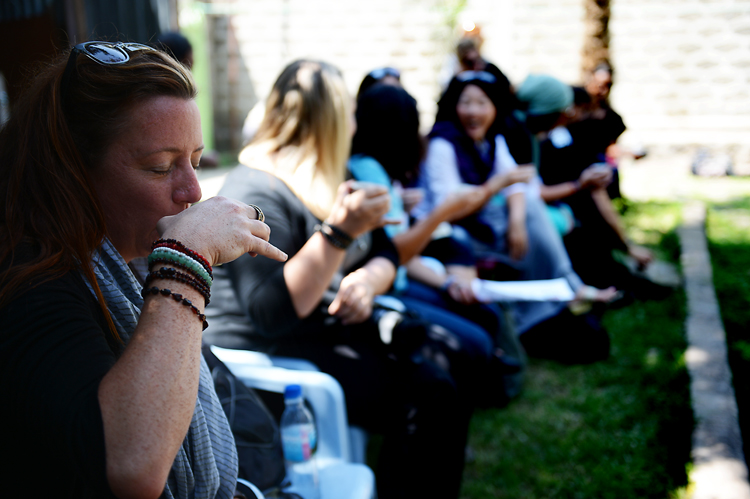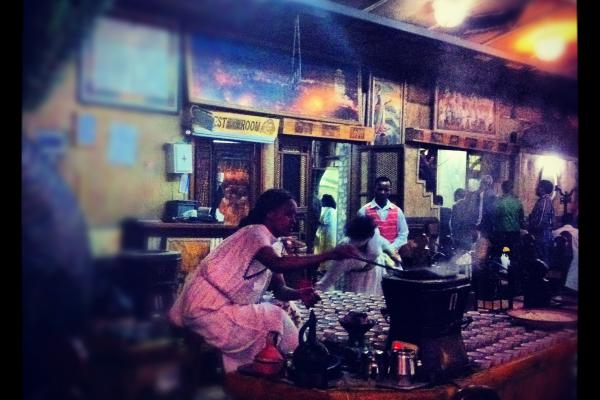Of all the exotic aromas and experiences from my sojourn in Ethiopia, it’s the frankincense I miss most.
Not the puffs of smoke emanating from a thurible swung by priest walking the center aisle or blessing a high altar. What I miss is an even more specific scent: the unmistakable mélange of frankincense and roasting coffee beans over a charcoal fire.
Frankincense and slow-roasted beans are the sacramental elements of the Ethiopian coffee ceremony – a rite at once ubiquitous and quotidian, transcendent and sacred. (This is where I wish there were a digital scratch-and-sniff function so you could experience the aroma I'm describing so anemically.)
Everywhere we went in Ethiopia, without fail a coffee ceremony had been arranged meticulously to welcome and honor us. Such ceremonies, we quickly learned, are an integral part of Ethiopian culture.
According to Epicurean.com:
The long involved process starts with the ceremonial apparatus being arranged upon a bed of long scented grasses. The roasting of the coffee beans is done in a flat pan over a tiny charcoal stove, the pungent smell mingling with the heady scent of incense that is always burned during the ceremony. The lady who is conducting the ceremony gently washes a handful of coffee beans on the heated pan, then stirs and shakes the husks away.
When the coffee beans have turned black and shining and the aromatic oil is coaxed out of them, they are ground by a pestle and a long handled mortar. The ground coffee is slowly stirred into the black clay coffee pot locally known as jebena, which is round at the bottom with a straw lid. Due to the archaic method used by Ethiopians, the ground result can be called anything but even, so the coffee is strained through a fine sieve several times. … The lady finally serves the coffee in tiny china cups [editor’s note: a cross between an Italian espresso cup and a Japanese sake cup] to her family, friends and neighbors who have waited and watched the procedure for the last half-hour. Gracefully pouring a thin golden stream of coffee into each little cup from a height of one foot without an interruption requires years of practice….
In most parts of Ethiopia, the coffee ceremony takes place three times a day -- in the morning, at noon and in the evening. It is the main social event within the village and a time to discuss the community, politics, life and about who did what with whom. If invited into a home to take part, remember -- it is impolite to retire until you have consumed at least three cups, as the third round is considered to bestow a blessing. Transformation of the spirit is said to take place during the coffee ceremony through the completion of Abol (the first round), Tona (second round), and Baraka (third round).
If memory serves, only once during our stay in Ethiopia did I have that third cup (and, it would seem, it’s accompanying special blessing.) I don’t know about blessing, but it did keep me especially awake and alert for the rest of the day (and much of the night.)
[view:Media=block_1]
Ethiopian coffee is rich, spicy, earthy. It is also the nation’s primary export and foreign capital generator, topping $840 million in 2010. It’s said that the best Ethiopian coffee is exported and the lesser quality beans kept in country. That may well be true, but the coffee I drank in country was far better than any Ethiopian Yirgacheffe I’ve ever tasted at a Starbucks or similar purveyor stateside.
Maybe that’s because of how coffee is not just tasted and consumed in Ethiopia, but how it is experienced.
Next to the small charcoal fire, over which the beans are roasted, is a vessel containing frankincense in its natural resin state. Frankincense comes from the dried sap (or resin) of the Boswellia sacra tree - a hearty tree that can grow in the most extreme conditions, in rocky soil, on cliffs and the steep sides of ravines.
One more than one occasion, the vessel holding the burning frankincense resembled a chalice, the kind we might find on a Christian altar during Eucharist, “Communion,” or (for lower-church folks) the “Lord’s Table.”
The first night we were in Addis Ababa, we went to a traditional restaurant in town where we happened to be seated next to the beautiful young woman whose job it was to continually prepare the coffee ceremony for all the customers. The aroma emanating from her little enclave [pictured at the top] was nothing short of intoxicating.
I kept leaning further in her direction until one of my traveling companions said, “Cath, let your hair down and just go over there and let the incense get all over it.”
I had tied my long, oft-unruly locks into a bun at the end of a long day. But like a penitent Rapunzel, I let down my hair, shook it out, and waved it over the incense.
Instantly I was reminded of the story from the Gospel of the woman (some say Mary Magdalene, who was, according to tradition at least, also a redhead) came to Jesus during a dinner, opened an alabastron of expensive oil (perhaps even frankincense, although more likely spikenard), anointed his feet (or his head, depending on which Gospel account you’re reading) with it, and weeping (or not, again depending on which account), wiped his feet with her locks.
The disciples were indignant about the woman “wasting” the precious oil on such an act. It could have been sold and the money given to the poor.
Jesus greeted his disciples grumbling with one of the most disconcerting and contentious verses in the New Testament when -- according to Mark 12, Matthew 26, and John 12. I like Eugene Peterson’s The Message para-translation of John 12:8 the best of all the synoptic accounts, which translates the verse as:
Jesus said, “Let her alone. She’s anticipating and honoring the day of my burial. You always have the poor with you. You don’t always have me.”
That verse has been used for centuries by many Christians to justify not working to alleviate poverty and its suffering. Jesus said we’d always have the poor, so what’s the point?
But I don’t believe that’s what Jesus meant. I believe he was pointing out that sometimes the choice is not between moral and immoral, ethical and unethical, but rather between moral and necessary.
Jesus knew he would be gone – physically, at least – soon. The woman’s choice to spend her precious oil the way she did wasn’t a moral choice. It was a necessity. She wouldn’t be able to do it later, after she’d helped the poor by selling her vessel of oil, because Jesus would be gone.
I can’t help but hear echoes of that in the Ethiopian coffee ceremony. Is it a moral, practical, or ethical choice to burn frankincense whilst roasting coffee beans by hand? Surely not.
But, the Ethiopians seem to be saying (without words), it is necessary. Because who knows when we’ll be together again? So let’s honor the time we have together, bless it, mark it as sacred – a sacred meeting of souls.
Back home in California, we recently purchased one of those one-cup-at-a-time Keurig coffee makers after running through two high-end traditional coffee machines in 18 months. (Two writers in one house equals a high rate of coffee consumption.) While I think it was the proper choice for us – we waste less coffee this way, and have bought one of those reusable pods so that we’re not always using recyclable-but-still-plastic-and-not-terribly-ethical disposable pods pre-filled with the coffee of our choice.
I brought home a pound or so of ground coffee from Ethiopia and we’ve tried to get the amount of grounds and water pressure just right to replicate the drink I’d had in Africa.
Nothing doing.
Ethiopian coffee ceremony a la Kuerig is too fast, too easy, and much too weak in myriad ways. 
In coffee ceremonies back in Africa, the beans were ground by hand with a mortar and pestle. They’d be uneven. Chunky. When steeped, the coffee needed to be sieved over and over to make the final product perfectly potable. It took time, patience, and a practiced hand. It also required a different kind of regard for the act itself: the woman preparing the coffee wasn't simply making a beverage. She was presiding over something humble and holy.
Even if I could replicate the grounds (I do have a Le Creuset mortar and pestle that mostly serves as decoration on my kitchen window sill), and sieved the elixir until it was just right, it still wouldn’t be.
Why? No frankincense and all the sacred intention that comes with it.
But it doesn't need to be so, I try to remind myself. It all depends on how I view the act -- sharing a coffee with another person or a group of people, even if they're just strangers biding their time before an early-morning flight out of LAX.
With or without incense, hand-roasted beans; steeped in an earthenware vessel, a French press, chrome percolator from the 1960s; served in tiny porcelain cups, big hearty mugs, or in a paper cup in the narthex of a church or in its basement at a 12-step meeting, coffee is a sacrament when it is shred.
Two souls. Two cups of coffee. One Spirit. And a sacred meeting, one sip at a time.
Cathleen Falsani is Web Editor and Director of New Media for Sojourners. Last month, Cathleen traveled to Ethiopia as an expense-paid guest of the ONE Campaign on a listening-and-learning visit to programs and organizations that work primarily with women and girls. Learn more about ONE Moms and the Ethiopia trip HERE. Watch for Cathleen's tweets (and those of her ONE Moms traveling companions) on Twitter with the tag #ONEMOMS.
Photo credit: All photos by Cathleen Falsani for Sojourners, except for the last two in the slide show and the bottom photo of the author, sipping her second cup of coffee during a ceremony in Addis Ababa last month, by Karen Walrond for ONE.
Got something to say about what you're reading? We value your feedback!
